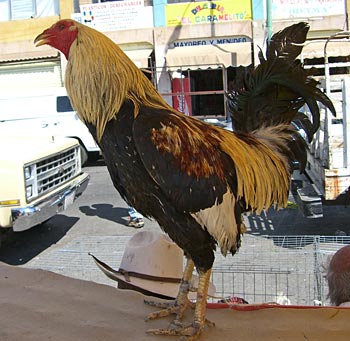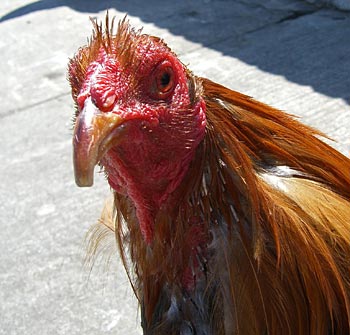
Morelia – ChessBase goes to the Market
By Federico Friedel
El Mercado de la Constitución, the big market of Morelia, is
something we had to see. People told us to go there if we wanted anything –
condiments, spices, chiles. Even clothing and utensils. Souvenirs. Anything
at all. It was true. This market, which is more like a city quarter, is gigantic,
diverse and one of the most exciting places we visited here in Morelia.

The road to the market, just a quarter of an hour from the hotel. It is faster
to walk than to us a cab, which needs to take a convoluted path to that area
of town.

The vegetable and herb section, which is much more diverse than the ones we
know from Italy, Spain or Turkey.

A proud fish vendor, who specifically requested that I retake the picture with
him holding the instruments of his trade. He would have loved to give us samples,
but what are you going to do with raw fish in a hotel room?

There is no fish stench in this section of the market, in spite of the great
quanitites and variety of sea and shellfish – and in spite of the warm
climate. The only explanation is that the products are very fresh and the displays
meticulously clean.

We now come to the Real Thing, the True Reason, ultimately, for our trip to
Mexico. Chilles. In a profusion we have never seen before. With an aroma we
have never smelt before.

The most expensive varieties cost 80 pesos per kilogram, which means a pillow-full
for about eight dollars. For the return trip I am thinking maybe two pillow-fulls?
Just hope I don't get into trouble with the German customs.
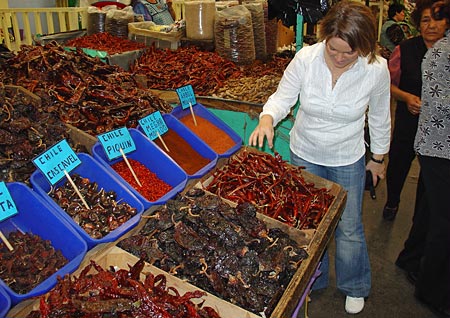
Nadja Woisin, good Northern German lady (mysteriously able to converse in perfect
Spanish) finds the chillies fascinating, especially the aroma.
Contemplating suicide? No, don't do it, girl! We need you for the Spanish language
news page, and all the gorgeous videos of chess events.
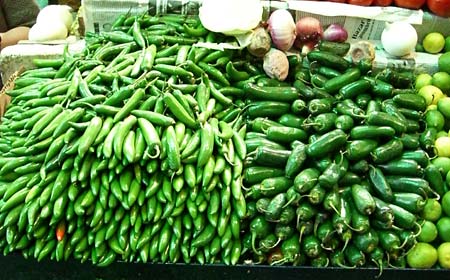
Serrano peppers on the left and jalapeño chile peppers. The
latter is famous for being terrifyingly hot, rating between 2,500 and 8,000
on the Scoville
scale of heat. The Serranos are 5,000 to 20,000 Scoville units. By comparison
Italian sweet bell peppers are rated zero, pepper is 100-500, Tabasco Sauce
is 2,500.

These are the baaad boys: habanero chiles. There are a number of varieties,
but the Red Savina habanero, which we suspect the above to be, has
a Scoville rating of 350,000 to 500,000. We will be bringing a bunch home with
us, packed in a reinforced bag. Yes, we know how to handle this kind of weapon.
At home we have bottled hot sauces which have well over 500,000 Scoville units.
They come with warnings "Use this product one drop at a time." and
"Not for people with heart or respiratory problems." You have to sign
a paper granting the distributor waiver of responsibility when you buy some
sauces. Paul Truong, who often sends us reports for our news page, has sauces
with over a one million SU. We hope Paul will also send us a couple of bottles
in the near future.
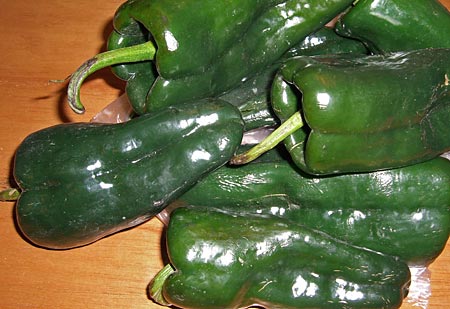
Aruna Anand, in far off Spain, advised us to buy and bring Poblano chiles.
They look like small bell peppers, but are noticably hotter in taste. Nowhere
near jalapeños or the rest, of course. Poblano chiles are roasted and
peeled prior to being used in soups, sauces and casseroles.

Apples and mangoes are there in a dozen varieties. Many different fruits, including
melon, pineapple and papaya, are chopped into small cubes with a giant knife
to make a fruit gaspacho. To it is added salt, chilly powder, hot sauce, orange
and lemon juice. It is sold at every street corner, is delicious and costs a
dollar a bucket.

Giant papayas,
the size of a man's head. A big man's head. Forget the little ones we get in
Europe, which have all the aroma of mineral water. These have your mouth watering
at twenty paces. Papayas, which are found in tropical countries all over the
world, were originaly native to southern Mexico and Central America.

These are (unpeeled) chayotes, which is an edible plant related to
the melons, cucumbers and squash. The flesh can be eaten raw in salads, but
it can also be boiled, stuffed, mashed, baked, fried, or pickled. As far as
we can tell it is always eaten with chilli sauces. We tried it in mole de olla,
where it is supposed to be especially delicious. It is. But then agan, most
things in Mexico are.

Mamey Sapote, which has a salmon pink flesh and a sweet, almond-like
flavor. It is often used to make ice cream. There is a large shiny seed in the
middle, which you can grow to a tree in a pot. Mameys can weigh between one
and six pounds per fruit. They cost about 20 pesos per kilogram.

Mezquite, which consist of flowers and fruit. The latter can be eaten
raw, the former are brewed to a tea.
A little Mexican boy accompanies his mother to the market. Small children are
everywhere, part of the landscape of these Mexican towns. Either there are more
of them than where we live, or they are taken out more often by their parents.
Mexican royalty enjoying the treats at the market.
Warning – distrubing images follow
 At
this point we need to warn our readers that some people may find the images
in the following part of our report disturbing. They involve different body
parts of animals that are sold at the market. These are normally referred to
as "meat", just that they are seldom displayed so explicitly in our
markets. Anyway, people with weak nerves, and also vegetarians (especially vegetarians)
should now click on the little red button on the top of the browser, take an
aspirin and return to our news pages in the morning. Please do not write to complain.
You have been warned, in the same spirit as the buyers of the hot sauces mentioned
above.
At
this point we need to warn our readers that some people may find the images
in the following part of our report disturbing. They involve different body
parts of animals that are sold at the market. These are normally referred to
as "meat", just that they are seldom displayed so explicitly in our
markets. Anyway, people with weak nerves, and also vegetarians (especially vegetarians)
should now click on the little red button on the top of the browser, take an
aspirin and return to our news pages in the morning. Please do not write to complain.
You have been warned, in the same spirit as the buyers of the hot sauces mentioned
above.
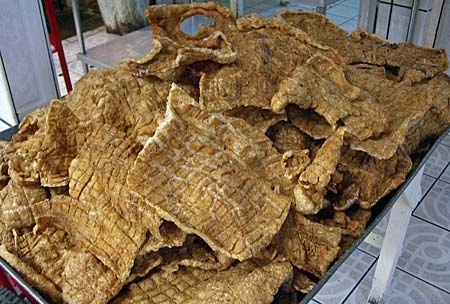
Mexican chicharron – this is basically fried pigskin which you
can get at every street corner and restaurant in the country. In the countryside
you see the fried skin of entire pig halves hanging on hooks. If you ask for
a piece the vendor will break it off with a blow of his elbow. You play about
5-10 pesos for a big piece, spiced with chilli and lemon. What Mexican men love
most of all in life is to sit around in front of a TV set, watching football
and dipping chicharron pieces in Salsa Valentina, while drinking good Mexican
beer. Not the most romantic of setups, and not the best way to woo your woman.
We did taste the chicharron-with-salsa – well, I just hope there is a
good football game on tonight.
Lungs, I think. You can buy every part of a variety of different animals at
the meat market. Sometimes it is probably better not to ask what exactly you
are getting.

Tongues and other parts of the head of bovine animals. Once again all remarkably
clean and unsmelly. Those tongues were probably licking just a few hours ago.

Filete au bisteck, the finest grill meat, and hearts of cows.
Are you still there? Well, then it is your own fault if you scroll on...
These two butchers posed for us. They were particularly proud of the cow's
heads.
This one was Najda's favourite – she though it had a friendly and, frankly,
sensuous expression.
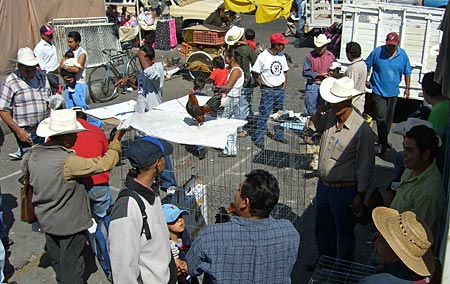
Yes, we know that cock fighting is a cruel and despicable sport. There was
an area of the market devoted to these birds, which filled the air with their
back-and-forth crowing.
"Si, son los gallos de combate", they told us. They are also called
"gallos de pelea" (pelea means fight, scrapö). This
was a prize bird, big, orgulloso (proud) and in general very, well, cocky.
This fellow spent some time contemplating its reflection in my camera lens.
Thankfully it realised that it was not the real thing, and thus I still have
use of the Canon.

Making friends with one of the poor (but proud!) creatures. "Did u wash
your hands after touching the H5N1?" wrote a friend in distant Spain, after
seeing this picture on our Spanish
news page.

Nadja, taking one of the pictures that appeared in that news story.
Photos by Frederic Friedel and Nadja Woisin
This is Juan Carlos García Franco, our adviser on all matters relating
to food and spices. His profession is Guitarra Clásica, which he plays
and teaches. He also composes guitar music. His hobby, he tells us frankly,
is food. On Sunday Juan Carlos has promised to take us to the market, where
we will buy last-minute fresh supplies to take back home to Germany.
Links





































 At
this point we need to warn our readers that some people may find the images
in the following part of our report disturbing. They involve different body
parts of animals that are sold at the market. These are normally referred to
as "meat", just that they are seldom displayed so explicitly in our
markets. Anyway, people with weak nerves, and also vegetarians (especially vegetarians)
should now click on the little red button on the top of the browser, take an
aspirin and return to our news pages in the morning. Please do not write to complain.
You have been warned, in the same spirit as the buyers of the hot sauces mentioned
above.
At
this point we need to warn our readers that some people may find the images
in the following part of our report disturbing. They involve different body
parts of animals that are sold at the market. These are normally referred to
as "meat", just that they are seldom displayed so explicitly in our
markets. Anyway, people with weak nerves, and also vegetarians (especially vegetarians)
should now click on the little red button on the top of the browser, take an
aspirin and return to our news pages in the morning. Please do not write to complain.
You have been warned, in the same spirit as the buyers of the hot sauces mentioned
above. 






